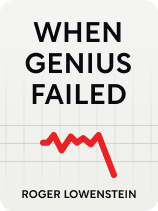

This article is an excerpt from the Shortform book guide to "When Genius Failed" by Roger Lowenstein. Shortform has the world's best summaries and analyses of books you should be reading.
Like this article? Sign up for a free trial here.
How was the hedge fund LTCM formed? Why was the hedge fund created in the first place?
Shortly after John Meriwether left Salomon Brothers, he sought to create a new fund. In When Genius Failed, Roger Lowenstein delves into the emergence of LTCM, its unique convergence strategy, and the high-risk, high-reward nature of its approach.
Continue reading to learn about the early years of LTCM.
Meriwether’s Vision: Long-Term Capital Management (LTCM)
Lowenstein writes that John Meriwether envisioned striking out on his own by applying the convergence strategy that had brought him success at Salomon Brothers. This marked the intellectual underpinning of what became the hedge fund LTCM.
The core strategy was simple: Buy assets identified as underpriced by their model while simultaneously shorting similar assets deemed overpriced. The premise was that the prices of these assets would eventually converge. In essence, LTCM aimed to “buy low and sell high” at the same time they were “selling high and buying low.”.
| The Role of “Black Swans” in Finance While convergence strategy may sound appealing in theory, Meriwether and his team may have overlooked its practical complexities and risks. As Lowenstein writes, the strategy relies on the concept that mispriced assets will inevitably correct themselves, leading to convergence. However, this strategy doesn’t account for “Black Swan” events, unpredictable and severe market disruptions. When these events occur, they can defy any expectations of convergence and lead to massive losses. Indeed, in A Random Walk Down Wall Street, Burton Malkiel writes that no matter how well-founded an investor’s determination of an asset’s value is, she can’t account for randomness—such as the appearance of a groundbreaking technology, a new legal regime, or a surprise event like a public health or environmental emergency. Malkiel writes that financial history is littered with “sure things” derailed by such randomness. |
Example: Shorting Stock
It’s worth exploring in a bit more depth what a “shorting” strategy is and how it plays into the overarching convergence strategy.
Shorting an asset is a way of placing a bet against it. If you believe, for example, that General Electric is about to sustain major losses, you can borrow shares of GE stock through your brokerage, with the promise to return those shares at an agreed-upon date. If the stock declines in value between when you borrow it and when you must return it, you earn a net profit on the transaction. If you borrow 10 shares of GE when it’s selling for $100 per share and then immediately sell those shares, you pocket $1,000. If they’re selling for $50 each when you need to purchase them in order to fulfill the contract, your net profit is $500—$1,000 minus the $500 you now need to spend to purchase the stock.
But if the stock has risen in value between when you borrowed the shares and when you must return them, you suffer a net loss on the transaction. If GE is trading at $150 per share when you have to return the stock, your net loss is $500—$1,000 minus the $1,500 you now need to spend to purchase the stock at its higher price.
Launching the Fund
To start his new fund, notes Lowenstein, Meriwether recruited a team of top-notch academic economists and central bankers, including Robert Merton, Myron Scholes (who would later win a Nobel Prize in economic sciences), and David Mullins.
Armed with his dream team, Meriwether and his fundraisers embarked on a roadshow, dazzling investors and successfully raising $1.25 billion in capital. They secured investments from European and Japanese banks, prominent American CEOs, and elite private universities.
Lowenstein writes that many of these key investors were wowed by the intellectual brilliance of the LTCM partners and the track record they had at other firms. Investors saw LTCM as low-risk since it was run by a team of ex-Salomon Brothers traders who had reached the pinnacle of financial success there—and they assumed the team could replicate that success. Crucially however, notes Lowenstein, most of these investors had little understanding of how LTCM’s complex trading strategy actually worked: They put their faith in the all-star partners roster and their sterling reputations.
With funding in place, Long-Term Capital Management commenced trading in February 1994, marking the start of an ambitious venture that would have a significant impact on the financial world.
| Theranos, LTCM, and the Failure of Due Diligence Lowenstein writes that LTCM investors put their faith in the background and reputation of the LTCM partners, despite having little understanding of the firm’s trading strategy. In effect, they trusted in the words and biography of the partners rather than performing due diligence about the soundness of the fund’s business operations. But LTCM wasn’t the last case of a supposedly groundbreaking company dazzling investors with promises of astronomical returns—and convincing those investors to forego due diligence. In Bad Blood, journalist John Carreyrou writes that medical startup Theranos (whose blood-testing technology was later revealed to be a fraud perpetrated by founder Elizabeth Holmes) lured investors and partners like Walgreens, taking advantage of that company’s short-sightedness. As Carreyrou writes, Walgreens couldn’t pull out of Theranos once it had already committed to its investment, despite mounting concerns about the startup. As with the investors that Meriwether brought into LTCM, Theranos investors like Walgreens failed to perform due diligence. Walgreens’s concern was that if Theranos’s innovation had turned out to be real, Walgreens couldn’t risk competitor CVS taking it. Furthermore, in a classic “sunk-cost” fallacy, Walgreens had already shouldered the money of building out new clinics with Theranos’s technology, and once it got deep enough, pulling out would have been intensely embarrassing. Another Theranos strategy was to land big-name investors—like former Secretaries of State George Shultz and Henry Kissinger, retired US Marine Corps General (and future Secretary of Defense) James Mattis, and former US Senator Sam Nunn. By reeling in these big fish, the company was able to boost its reputation and lure in overly enthusiastic investors who failed to investigate the validity and viability of the company’s technology. |
Leverage: Amplifying the Strategy
Lowenstein writes that what set LTCM’s approach apart was its use of substantial leverage, i.e., borrowed funds, to increase its volume of trades. Since price differences between the bonds they traded were marginal, the profits per trade were minimal. To generate substantial profits, LTCM needed to execute trades at high frequencies and volumes, which required a significant reserve of capital. And they could only acquire those reserves through borrowing. The strategy was an inherently “high risk-high reward” one for LTCM: If their model succeeded, profits could be magnified manifold times through leverage. However, if the model failed, losses would also be greatly amplified due to the debt incurred.
(Shortform note: LTCM’s high use of borrowed funds touches on an important concept in finance known as leverage ratio. A leverage ratio is a critical financial metric used to assess the capital adequacy and risk exposure of financial institutions, such as banks and investment firms like LTCM. The leverage ratio is calculated by dividing the institution’s Tier 1 capital by its average total consolidated assets. Tier 1 capital is the core capital of the institution and includes common equity and retained earnings. Typically, regulatory authorities set minimum leverage ratio requirements for financial institutions. These requirements are in place to ensure that institutions maintain a minimum level of capital relative to their total assets.)
However, banks were willing to provide loans generously due to the perceived prestige of LTCM. Despite LTCM’s lack of transparency and secretive internal culture, the banks competed for the opportunity to lend to LTCM, seeing the new hedge fund as a potentially valuable client. Accordingly, the banks were willing to lend on highly favorable terms—even if they had a difficult time understanding exactly what LTCM was doing.
| Information Asymmetry Leads to Poor Decisions The banks’ failure to understand LTCM’s business model (despite investing heavily in it) demonstrates the point that people often make decisions with flawed or incomplete information. In Freakonomics, authors Stephen J. Dubner and Steven Levitt write about the phenomenon of information asymmetry—situations where information is unequally distributed between parties. Dubner and Levitt warn that experts can skillfully exploit information asymmetry when they leverage their superior knowledge to gain the upper hand over their counterpart in a transaction or negotiation. Information asymmetry can have a systemwide impact, with the 2008 financial crisis as a prime example. In the run-up to the crisis, Wall Street financiers created products like derivatives (financial instruments whose value derives from an underlying asset) and collateralized debt obligations (complex financial products that bundle various debt assets, such as mortgages or bonds, into one security) whose larger implications many investors simply didn’t understand. When the housing market collapsed, those investors who bought these products were wiped out, while the sellers, who possessed a major information advantage, made a tidy profit. |

———End of Preview———
Like what you just read? Read the rest of the world's best book summary and analysis of Roger Lowenstein's "When Genius Failed" at Shortform.
Here's what you'll find in our full When Genius Failed summary:
- The 1998 collapse of Long-Term Capital Management (LTCM)
- The history of LTCM, how it operated, and how it achieved success
- Insights to the LTCM story in light of subsequent events






